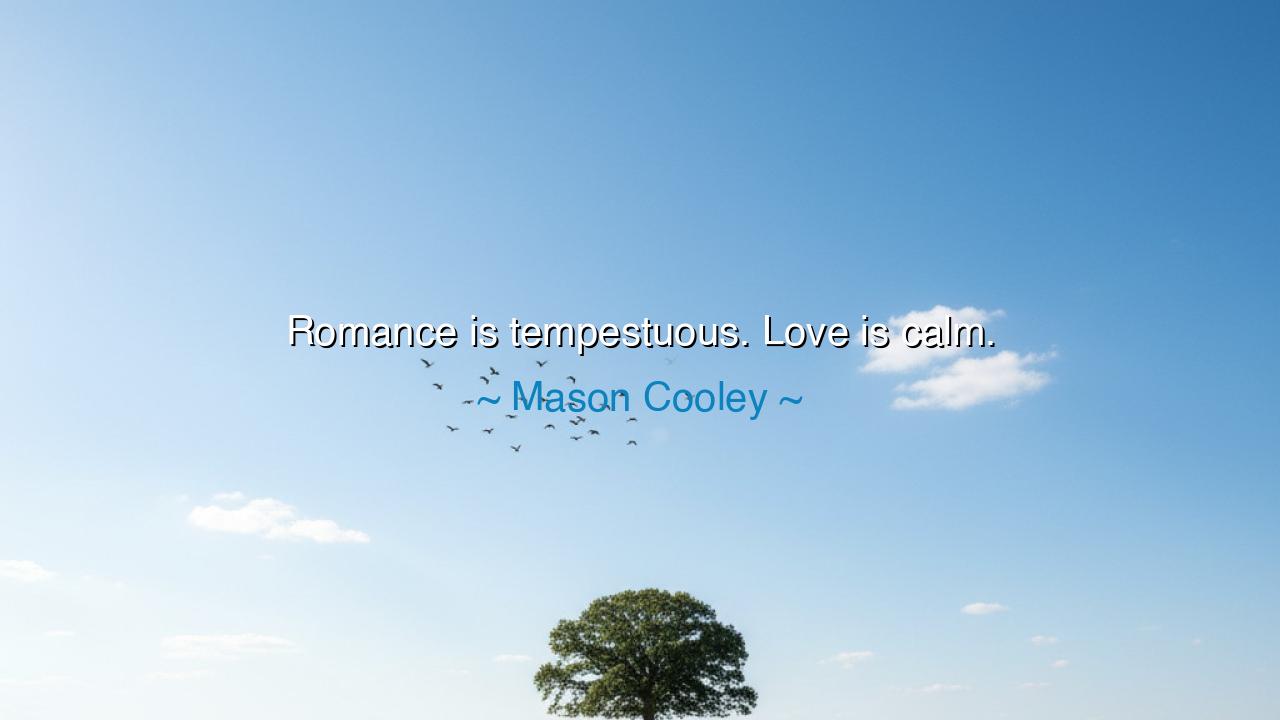
Romance is tempestuous. Love is calm.






Mason Cooley, with the clarity of a sage, once declared: “Romance is tempestuous. Love is calm.” In these words lies a great distinction, one that poets and philosophers through the centuries have sought to grasp. Romance is like the storm at sea—fierce, thrilling, unpredictable. It lifts the heart to dizzying heights, but may also dash it upon the rocks. Love, by contrast, is the harbor—the still waters where the soul finds peace, safety, and rest. Cooley reminds us that passion and permanence are not the same: romance is the spark, but love is the flame that warms through the long night.
The origin of this wisdom is found in the human experience itself. Every culture has celebrated romance in song and story: the whirlwind of attraction, the fever of desire, the drama of pursuit. Yet just as often, they have spoken of love as something deeper, quieter, and more enduring. The Greeks spoke of eros and agape; one burning with hunger, the other steady with selfless devotion. Cooley, in his brief aphorism, gathers these ancient truths into a single, memorable contrast.
History abounds with examples of this truth. Think of Romeo and Juliet, the very embodiment of tempestuous romance. Their love flared brightly, defying families, traditions, and fate. It consumed them, but like a storm, it could not last. Their passion shook Verona, but left behind tragedy. This was romance in its most tempestuous form, dazzling yet fleeting. It shows us the danger of mistaking intensity for endurance.
Yet there is also the story of Elizabeth Barrett and Robert Browning, poets who began in secret letters and grew into a lifelong bond. Their romance had passion, yes, but it matured into calm devotion. Through illness, exile, and hardship, their love endured like a steady flame. Where Juliet and Romeo knew the storm, Elizabeth and Robert knew the harbor. Their lives illustrate Cooley’s words: romance ignites, but love sustains.
The deeper meaning, then, is this: while romance may sweep us from our feet, it is not meant to carry us forever. The storm awakens the heart, but the calm nourishes the soul. Romance is the doorway through which many enter, but only love allows us to remain. Passion without calm burns out; calm without passion may never begin. The balance lies in allowing tempestuous romance to mature into tranquil love.
The lesson for us, O seekers of wisdom, is to honor both. Do not despise romance, for it gives fire to the soul and stirs the imagination. But do not cling only to its storms, for they will tire the heart. Seek instead to build a love that is calm—where trust, respect, and kindness prevail. This calm is not dullness, but the deepest strength, for it is love that endures through time, sickness, and change.
Practical wisdom follows: nurture your relationships not only with passion but with patience. Let romance light the path, but let love build the foundation. Show your devotion not only in grand gestures, but in daily faithfulness—listening, forgiving, supporting, and remaining steadfast. For in these acts, passion finds its home in peace, and romance transforms into the calm strength of true love.
Thus Mason Cooley’s words endure as both warning and blessing: “Romance is tempestuous. Love is calm.” To mistake one for the other is to risk heartbreak. But to embrace both in their season is to walk the full path of the human heart—from the storm to the still waters, from the thrill of the beginning to the peace of eternity.






AAdministratorAdministrator
Welcome, honored guests. Please leave a comment, we will respond soon